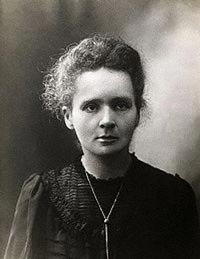
| Born: Nov 7, 1867 in Warsaw, Kingdom of Poland, then part of Russian Empire |
| Died: Jul 4, 1934 (at age 66) in Passy, Haute-Savoie, France |
| Nationality: French, Polish |
| Famous For: Radioactivity, polonium, radium |
| Awards: Nobel Prize in Physics (1903), Davy Medal (1903), Matteucci Medal (1904) and Nobel Prize in Chemistry (1911) |
Marie Curie was born Maria Sklodowska to two teachers in Poland. Because her parents were involved in Polish nationalism, they were oppressed by the Russian authorities, which ran Poland at the time. Marie’s father was forced to stop giving lab instruction to his students and hence was forced to bring his lab equipment to his home. There he encouraged his children, including Marie, to use it.
Marie was a brilliant student and wished to teach, but she could not enroll in college because she was a woman. She and her sister Bronislawa founded a secret school called the Flying University, which admitted girls and, somewhat more dangerously, taught a curriculum that was decidedly pro-Polish. Marie Curie was always fiercely proud of her Polish heritage, even when she lived in France. She made sure that her daughters learned the Polish language.
Paris
Eventually, after a time of hardship, Marie came to Paris to study physics, mathematics and chemistry at the Sorbonne. Her hardships did not end when she moved to Paris, and she took tutoring jobs to make ends meet. She earned her physics degree in 1893 and a math degree in 1894.
Soon after this Marie was introduced to Pierre Curie, who taught at the School of Physics and Chemistry. They were married in 1895. Marie was reluctant at first because she had always planned to return to Poland, but Pierre claimed that he would move to Poland with her. Marie returned briefly to Poland but could not get a job at an institute of higher education because of her gender. She returned to Paris both to pursue her career and to be with Pierre.
Radioactivity
The year after her marriage, French physicist Antoine Henri Becquerel discovered natural radioactivity and the Curies became interested in the radiation emitted by natural substances. Marie and Pierre worked together to investigate these properties.
The Curies discovered that uranium ore had much more radioactivity than could be accounted for by the uranium alone. Marie and Pierre extracted small amounts of very radioactive new chemical elements from uranium ore. They named these new elements radium and polonium after Marie’s country of birth. In 1903, Marie and Pierre Curie shared the Nobel Prize for physics with Becquerel. This award made Marie Curie the first person of her gender to win the Nobel Prize. Additionally, she is so far the only woman who has won in both physics and chemistry.
After Pierre
Pierre died in 1906. At the time he was a professor at the Sorbonne and Marie was appointed as a professor in his place. She was also instrumental in founding the Radium Institute in Paris and was its first director. During World War I, she and her eldest daughter Irene, who was only 17 at the time, brought a mobile radiographic unit to the front. After the war Irene served as her mother’s assistant in the Radium Institute.
Marie Curie died in 1934 of aplastic anemia, a disease where the bone marrow and stem cells of the blood are destroyed. The disease was a consequence of her unprotected exposure to radiation. She was first buried at Sceaux and then her body was moved to the Pantheon in Paris.